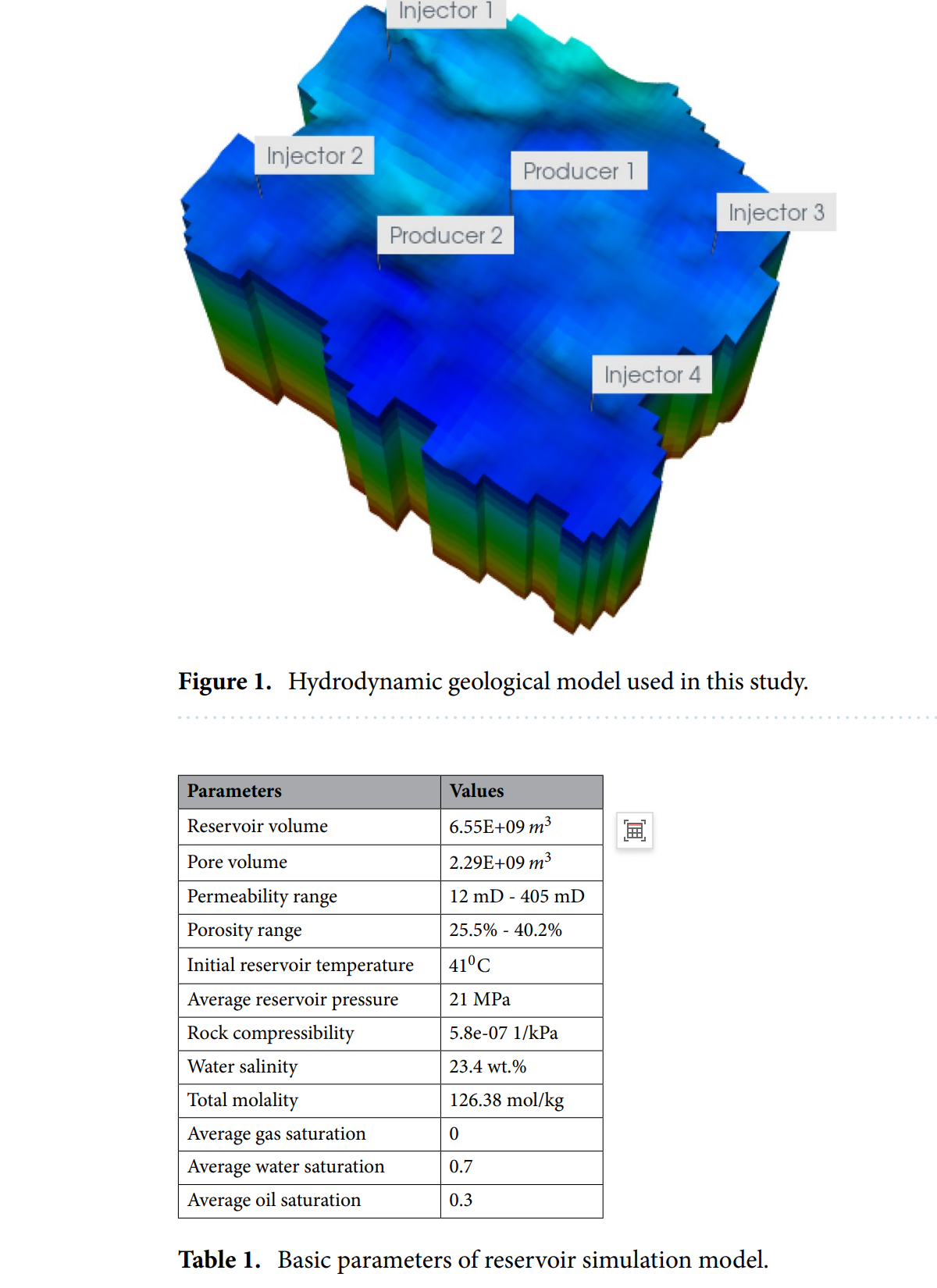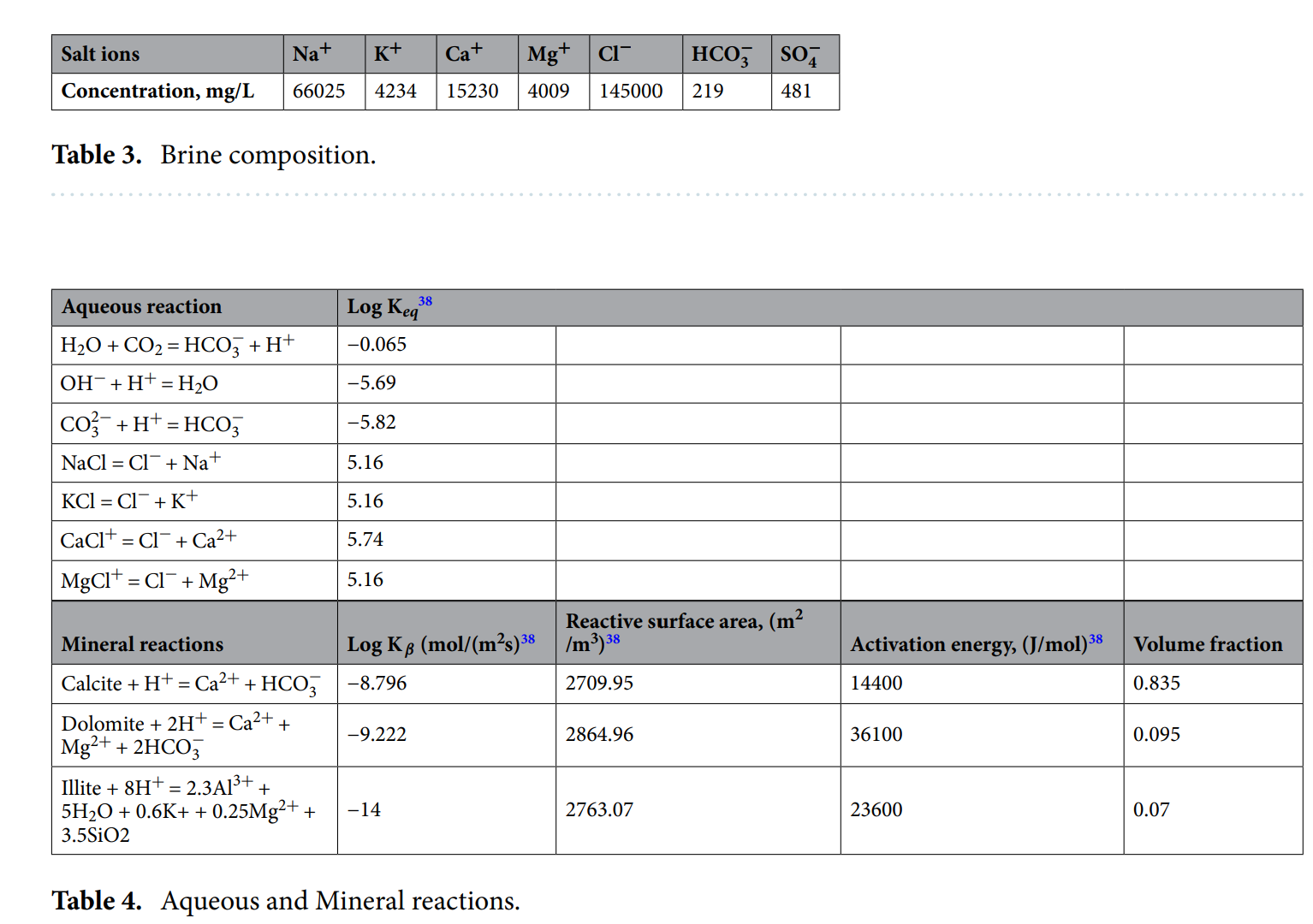A numerical feasibility study of CO2 foam for carbon utilization and storage in a depleted, high salinity, carbonate oil reservoir
本文研究了二氧化碳泡沫用于协同优化高含矿化度碳酸盐岩地层中提高石油采收率(EOR)和二氧化碳封存的可行性。模拟的水动力学模型是一个含有30%残余油的枯竭地层,具有三种二氧化碳封存机制:溶解、残余和矿化封存机制。结果显示,在20年后,泡沫注入期间的油采收率是二氧化碳注入的2.7倍,而泡沫驱替期间封存的二氧化碳比二氧化碳注入高出38%。
值得注意的是,泡沫注入还使二氧化碳储存能力提高了2.6倍,表明在模拟模型中有潜力储存约2千兆吨的二氧化碳。这归因于泡沫显著降低气体流动性,并通过对Jamin效应形成孤立气泡。残余封存是主要的封存机制,占总封存量的70%以上,这是由于由于水介质的高盐度导致二氧化碳在盐水中的溶解度降低。本研究展示了一种新的二氧化碳利用和封存技术,通过将二氧化碳作为泡沫注入,同时在枯竭的油藏中提高油采收率并实现二氧化碳的封存。本研究的相关性在于其潜力,可以提供减少温室气体排放和提高石油产量的双重好处,为石油工业提供一种可持续的方法。
CMG软件应用情况:
在本研究中,使用了CMG-GEM组成模拟器来代表置换和封存过程。该模拟器依赖于具有理论参数的状态方程(EOS),能够预测油气储层中典型烃类的流体行为。特别是,该模拟器内的二氧化碳模块被用来模拟二氧化碳注入和封存在枯竭的油藏中,以及伴随的水相化学反应、矿物沉淀和溶解过程。模拟二氧化碳封存涉及解决组分传输方程、控制气相和水相之间热力学平衡的方程,以及考虑水相物种与矿物沉淀/溶解之间反应的地球化学方程。



结论:
本研究通过数值模拟泡沫在模拟枯竭油藏的水动力学模型中的使用,该模型具有0.3的残余油饱和度。以二氧化碳泡沫的形式注入,双重目的是提高油气开采和二氧化碳封存。模拟了溶解、残余和矿化封存机制,并对结果进行了分析。本工作的主要发现可以总结如下:
- 泡沫注入使油产量至少比气体注入高出2.3倍。这一增加是由于二氧化碳的显著扩散和提高体积扫效率。气体注入主要通过油区的通道,留下大量未产出的油,而泡沫通过增强粘度和控制气体流动性来减轻这一问题。
- 在20年的生产期结束时,二氧化碳注入后,只有25.68%的注入二氧化碳仍留在储层中,而采用泡沫注入,这一比例为50.34%。
- 在泡沫注入期间,二氧化碳的理论储存能力提高了2.6倍,显示出在模拟的水动力学模型中有潜力储存1.95千兆吨的二氧化碳。
- 在枯竭的油藏中,二氧化碳封存的泡沫机制包括气体捕集、减少重力分异和封锁二氧化碳泄漏路径。
- 残余封存机制占总封存量的70%以上,是最主要的封存机制。同时,由于盐水的高矿化度,溶解封存仅占总封存量的约20%。
- 矿物封存的低效率可能归因于相对较短的模拟持续时间100年。有效的二氧化碳矿化过程通常需要数百到数千年才能发生。
- 与气体注入相比,泡沫注入期间矿物封存增加了67%,表明表面活性剂的重要贡献。应进一步进行实验研究,以调查表面活性剂对岩石矿化的影响。
随着地下二氧化碳储存日益成为通过减少大气二氧化碳水平来缓解气候变化的关键策略,泡沫注入技术有潜力被优化并适应于枯竭油藏之外的各种类型的地质构造。此外,未来的工作可以关注二氧化碳在这些储层中的长期行为,特别是增强需要更长时期才能有效的矿物封存机制。此外,应对大规模泡沫注入项目的经济效益和环境影响进行全面评估,以确保它们的可持续性和成本效益。
Abstract
Carbon Capture, Utilization, and Storage (CCUS) offers a viable solution to reduce the carbon footprint in the petroleum industry, and foam injection presents a promising method to achieve this while simultaneously increasing oil recovery. In this work, we studied the feasibility of CO2 foam for co-optimizing enhanced oil recovery and CO2 storage in a high-salinity carbonate formation. The simulated hydrodynamic model is a depleted formation containing 30% residual oil, with three mechanisms for CO2 storage: solubility, residual, and mineralization trapping mechanisms. The results showed that after 20 years, oil recovery during foam injection was 2.7 times higher than CO2 injection, and the CO2 stored during foam flooding was 38% higher than CO2 injection. Notably, foam injection also increased CO2 storage capacity by 2.6 times, indicating the potential to store around 2 gigatons of CO2 in the simulated model. This was attributed to the ability of foam to significantly reduce gas mobility and thus form isolated bubbles through its Jamin effect. Residual trapping was the dominant trapping mechanism, contributing to over 70% of the total CO2 trapped, attributed to the reduction in the dissolution of CO2 in brine due to the high salinity of the aqueous medium. CO2 mineralization was also studied, showing the least trapping efficiency and the dissolution trend of all the carbonate minerals. This study illustrates a novel CO2 utilization and storage technique in which CO2 is concurrently sequestered while enhancing oil recovery in a depleted oil reservoir by injecting CO2 as foam. The relevance of this study lies in its potential to provide a dual benefit of reducing greenhouse gas emissions and boosting oil production, offering a sustainable approach for the petroleum industry.
作者单位:
莫斯科斯科尔科沃科学技术学院石油科学与工程中心
